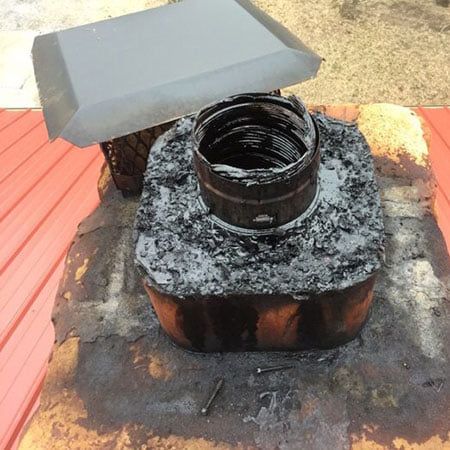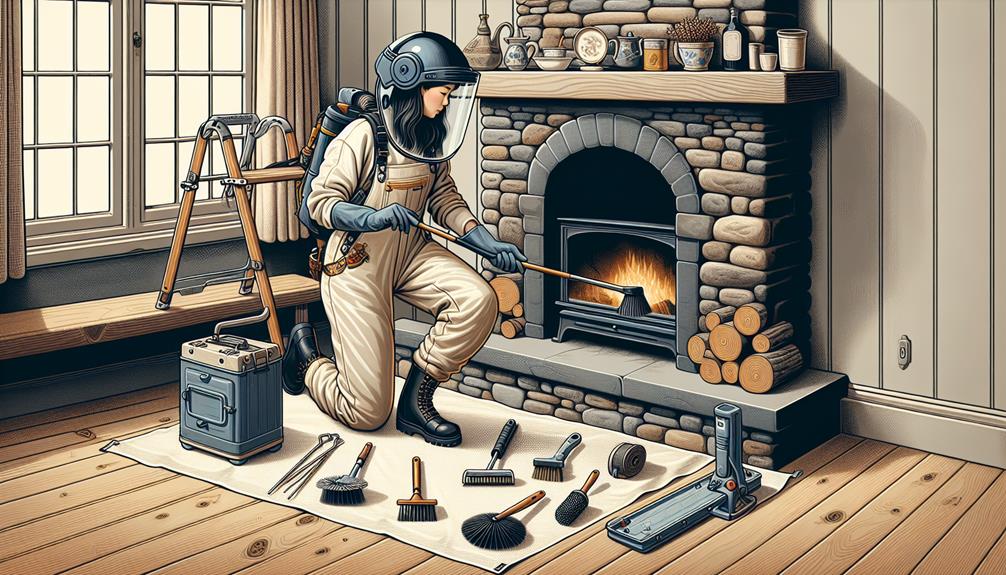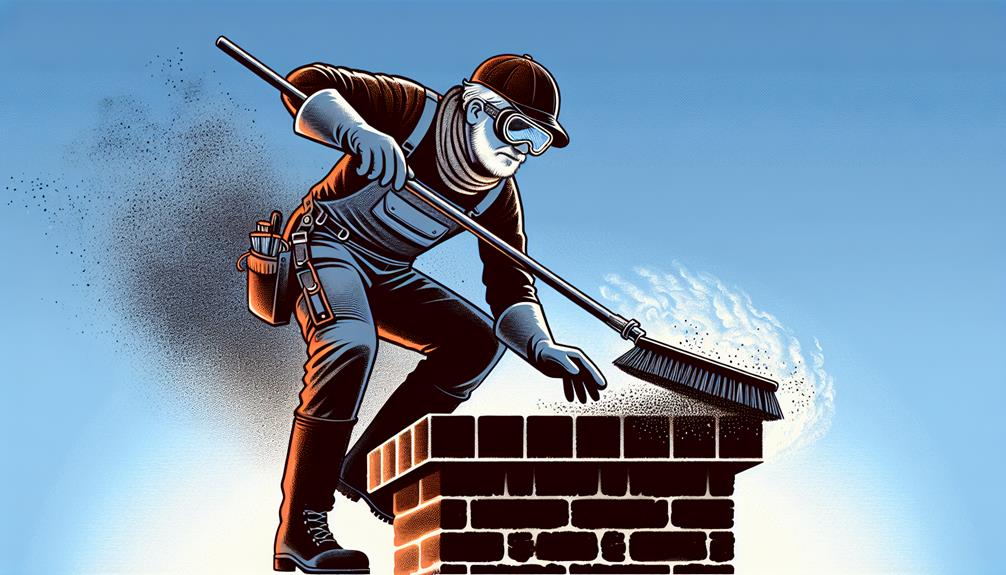Chimney cleaning logs, also known as creosote sweeping logs, are logs made to be burned in a fireplace or wood stove to help remove creosote buildup in the chimney. Creosote is a tar-like byproduct of burning wood that accumulates on the inner walls of the chimney. An excessive buildup of creosote is dangerous as it is highly flammable and a major cause of chimney fires.
Chimney cleaning logs work by emitting chemicals as they burn that react with the creosote and cause it to become brittle and flaky. This allows some of the creosote to break free from the chimney walls and fall to the bottom of the chimney where it can be swept out.
How Do Chimney Cleaning Logs Work?
Chimney cleaning logs contain chemical additives that are released when burned. The chemicals rise up the chimney and adhere to the creosote deposits on the chimney walls.
The chemicals cause a chemical reaction that dries out and crystallizes the creosote. This turns the creosote brittle so that it cracks and flakes off the chimney walls.
The flaky creosote then falls to the bottom of the chimney where it can be removed by sweeping. Chimney cleaning logs can reduce creosote buildup by up to 60% when used on a regular basis.
However, chimney cleaning logs only work on the first two stages of creosote formation:
- Stage 1 creosote – This is freshly deposited creosote that has a high soot content. It has a light, flaky texture and is relatively easy to remove.
- Stage 2 creosote – This creosote has hardened over time into tar-like flakes. It can still be removed by vigorous sweeping and brushing.
Chimney cleaning logs are ineffective at removing stage 3 creosote. Stage 3 creosote has hardened into a thick, glassy glaze that firmly adheres to the chimney walls. This type of creosote buildup often requires professional cleaning and sometimes relining of the chimney.
Are Chimney Cleaning Logs Safe To Use?
Chimney cleaning logs are generally considered safe to use when directions are followed properly. Key safety tips include:
- Use only 1 chimney cleaning log at a time. Burning multiple logs together can overheat the chimney and pose fire risks.
- Leave the packaging on the log if instructed to do so. The packaging helps moderate the burn rate.
- Don’t poke or stoke the log once lit. Allow it to burn undisturbed according to package directions.
- Ensure the chimney damper is open and there is adequate air flow in the room.
- Allow the chimney to cool sufficiently before burning regular fires after using a cleaning log.
- Check for and remove fallen creosote debris from the firebox after use.
- Avoid use in flues shared by multiple appliances that rely on exhaust drafting.
When used as directed, chimney cleaning logs are generally safe. However, they are not a substitute for professional chimney cleaning and maintenance.
Do Chimney Cleaning Logs Really Work?
Chimney cleaning logs can be an effective supplemental tool when used properly, but have limitations:
- They are only partially effective at removing stage 1 and 2 creosote. Removal is not 100%.
- They are ineffective on glazed stage 3 creosote. This requires professional cleaning.
- The amount of creosote removal varies based on frequency of use. More frequent use provides better results.
- Fallen creosote still requires removal from the firebox. The logs alone don’t eliminate it entirely.
- The chemicals can only treat creosote deposits within the direct chimney flue. Offsets and complete systems still require professional cleaning.
- The effects are temporary. Creosote starts reforming after each use and still necessitates annual professional cleaning.
So while useful, chimney cleaning logs have limitations. When used consistently throughout the burning season and paired with annual professional cleaning, they can be an effective complement but not a substitute for proper chimney maintenance.
Pros of Using Chimney Cleaning Logs
Chimney cleaning logs do offer some useful advantages when used properly:
- Provide supplemental cleaning between professional chimney cleanings.
- Help loosen and remove creosote deposits.
- Can shorten professional cleaning time required.
- Are easy and convenient to use. Simply place on hot embers like an ordinary log.
- Are non-toxic and safe when directions are followed.
- Reduce creosote accumulation over the season when used consistently.
- Can help prevent chimney fires caused by creosote buildup.
- Provide a chemical cleaning that can reach creosote out of reach of brushing.
For many homeowners, using chimney cleaning logs a few times throughout the burning season can help keep creosote under control in between professional chimney cleanings.
Cons of Using Chimney Cleaning Logs
Despite their advantages, chimney cleaning logs also come with some drawbacks and limitations:
- Provide only partial creosote removal. Complete removal still requires professional cleaning.
- Are ineffective at removing glazed stage 3 creosote residue.
- Can overheat the flue if used improperly or too frequently.
- Require proper ventilation to work safely.
- Don’t eliminate the need for annual professional chimney inspections and cleanings.
- Have no impact on flue offsets, catalytic combustors, or complete chimney systems.
- Offer only temporary benefits. Creosote starts reforming immediately after each use.
- Aren’t compatible with all chimney and wood stove types. Check device compatibility before use.
- Require fallen creosote to be manually removed from the firebox.
For these reasons, chimney cleaning logs work best as a supplemental cleaning aid rather than a standalone solution. Improper use or over-reliance can lead to safety hazards.
How Often Should You Clean The Chimney?
Chimney cleaning frequency depends on several factors:
- Wood type – Harder woods produce less creosote than soft woods. Seasoned wood creates less creosote than unseasoned.
- Use frequency – Chimneys used more often need more frequent cleaning. Occasional use requires less frequent cleaning.
- Creosote accumulation – Faster creosote buildup necessitates more frequent cleaning. Slower buildup allows for less frequent cleaning.
- Chimney type – Prefabricated chimneys often require more frequent cleaning than masonry.
- Geography – Colder climates promote faster creosote accumulation due to lower flue temps.
The National Fire Protection Association (NFPA) recommends:
- Wood stoves: Clean chimney at 1/8″ creosote buildup or every 2 months minimum during heating season.
- Fireplaces: Clean chimney at 1/8″ buildup or every 4 months minimum during season.
- All chimneys: Annual professional cleaning recommended as minimum.
Chimney cleaning logs can supplement but not replace this recommended cleaning schedule. Their use allows some flexibility in cleaning frequency but does not eliminate the need for periodic professional cleaning.
When Should You Hire A Professional?
Professional chimney cleaning provides a more thorough and complete cleaning than chimney logs alone can offer. Hire a professional chimney sweep if:
- It’s been over 1 year since last professional cleaning.
- Creosote buildup exceeds recommended limits.
- A chimney fire or other hazard occurs.
- New cracks, blockages, or other issues are noticed.
- Flue draft seems impaired.
- Smoke backdraft occurs.
- You need a thorough inspection.
- Chimney cleaning logs haven’t sufficiently improved buildup issues.
- Accessing high creosote deposits proves difficult.
For optimal safety and performance, make professional chimney cleaning an annual routine service. Be sure to also have a Certified Chimney Specialist evaluate any hazard signs or concerning issues as soon as they arise.
If you use a chimney cleaning log regularly, they can work well. But you should get a professional cleaning as well. Not only can a chimney sweep get rid of stage one creosote, but a pro can clean up stages two and three as well. While a chimney sweeping log loosens creosote buildup, it won’t get rid of it.https://priddychimney.com/chimney-cleaning-logs/.
When To Use A Chimney Cleaning Log
Chimney cleaning logs can be a handy way to help reduce creosote buildup between professional chimney cleanings. However, it’s important to understand when to use them and how to get the most benefit. Here are some tips on the optimal use of chimney cleaning logs:
Use at the Start of Burning Season
The beginning of heating season after a long warm-weather break is an ideal time to use a chimney cleaning log. Burning one before you create the first fires of the season can help:
- Loosen any creosote that may have accumulated over the summer.
- Prepare the chimney for the soot and deposits to come.
- Reduce risk of chimney fires as you resume burning.
Starting fresh helps maximize the benefits during the coming colder months when you’ll burn more frequently.
Burn After Establishing Proper Draft
Don’t use a cleaning log to establish initial draft when first lighting a fireplace after disuse. Burn 2-3 normal fires first to ensure proper draft before using a cleaning log. This prevents:
- Excess heat buildup if draft is obstructed.
- Wasted chemicals if smoke goes back down chimney.
- Possible smoking into the room.
Let the initial fires fully establish good draft flow first.
Allow the Firebox to Cool
Only place a chimney cleaning log on a cool firebox filled with ashes. Don’t put it directly on burning embers or hot logs. High heat can cause:
- Excessive temperatures that can crack tiles.
- Dangerous creosote drips down the chimney.
- Warping of metal firebox liners.
- Damage to the log chemicals before they fully activate.
Let the firebox cool completely between fires before placing the log.
Avoid Use on Wet Wood Fires
Don’t use chimney cleaning logs when burning wet, unseasoned wood. Wet wood produces excessive smoke and creosote. This can deposit debris beyond the cleaning log’s reach. Use them only for seasoned firewood burns for optimal effectiveness.
Time According to Creosote Formation
Target cleaning log use when creosote deposits begin forming in earnest – usually November to February in colder climates. Using them too early when deposits are light wastes the chemicals. But don’t wait until deposits have hardened extensively. Time their use with actual creosote accumulation.
Supplement Professional Cleaning
Regardless of cleaning log use, always get an annual professional chimney inspection and sweeping. Logs reduce but don’t eliminate the need for thorough professional cleaning and maintenance. Use them to supplement, not replace, professional chimney care.
How To Get The Most Out Of Chimney Cleaning Logs
While chimney cleaning logs can help reduce creosote buildup, their effectiveness depends on proper use. Follow these tips to get the most benefit:
Choose the Right Log
- Select a log designed for your specific appliance – fireplace, woodstove, etc.
- Match log size to firebox size. Too small is ineffective. Too large can overheat.
- Verify proper burn time to complete the cleaning cycle.
- Ensure the log fits space constraints without jamming draft.
Using the right log avoids safety issues and provides sufficient cleaning action.
Check Packaging Instructions
- Follow all directions for handling, storage and use.
- Note if packaging should be removed or left on.
- Check recommended burn procedures.
- Confirm ideal frequency guidelines.
- Review proper disposal methods.
Following all manufacturer instructions optimizes performance and safety.
Inspect the Chimney Beforehand
- Check for cracks or damage requiring repair before use.
- Scan for obstructions that could cause smoke buildup.
- Confirm the flue is clear of nests or debris before proceeding.
Inspecting first prevents wasted effort and alerts you to any problems needing correction.
Allow Adequate Airflow
- Keep the damper fully open.
- Open a nearby window temporarily if possible.
- Clear room obstructions restricting air access to the fireplace.
Sufficient airflow prevents smoky backdrafting during use.
Let the Log Burn Completely
- Don’t stoke the fire or add other wood while the log burns.
- Allow it to burn down completely according to directions.
- Keep the ashes undisturbed for 1-2 days after it finishes.
Burning the log completely without disruption allows the chemicals to work fully.
Proper set-up, use, and follow-up helps chimney cleaning logs work to their highest potential for reducing creosote before your next professional chimney cleaning.
Optimal Fireplace Maintenance Routine
For safe, peak-performance fireplace operation, follow this complete maintenance routine:
Monthly
- Check for creosote buildup and clean if over 1/8 inch thick.
- Burn a chimney cleaning log (up to 2x per month if needed).
- Check flue draft.
- Inspect for any damage or obstructions.
- Remove fallen debris from firebox.
Annually
- Schedule professional chimney cleaning and inspection.
- Repair any damage or issues detected.
- Consider flue relining if glazing persists.
- Check firebox, damper, and chimney cap.
- Clean out rain cap screen if applicable.
As Needed
- Replace fireplace screens if damaged.
- Repoint masonry or refinish firebox as required.
- Upgrade fireplace components if warranted.
- Address smoking, backdrafting or insufficient draft.
- Fix cracked tiles, damaged mortar joints, etc.
Preventative
- Only burn seasoned hardwood.
- Operate dampers properly to maintain draft.
- Avoid burning trash, cardboard or debris.
- Extinguish fires completely.
- Keep nearby combustibles clear.
- Teach children fireplace safety.
Improving Ineffective Chimney Cleaning Logs
If your chimney cleaning logs don’t seem as effective as you need, try these troubleshooting tips:
Analyze Creosote Formation
- Identify the type of creosote accumulated to target product selection.
- Determine the rate of buildup through frequent inspection.
- Adjust log use according to actual accumulation patterns.
Matching the log to your specific creosote formation improves results.
Increase Frequency of Use
- Using 1-2 logs monthly provides better control than 1 per season.
- Set a consistent schedule for periodic use.
- Increase frequency if buildup persists between cleanings.
More regular cleaning log use keeps creosote formation in check better.
Ensure Proper Log Use
- Review manufacturer instructions to confirm correct usage.
- Allow adequate air flow during use.
- Let log burn completely down.
- Give chemicals full contact time before next fire.
Correct use ensures the active ingredients work properly.
Upgrade Log Rating
- Switch to a higher intensity chimney cleaning log if needed.
- Look for versions certified for either Stage 2 or 3 creosote.
- Consider logs boosted with antioxidants for added effectiveness.
Using a more powerful log rating can boost cleaning performance on stubborn buildup issues.
Improve Combustion Conditions
- Burn only seasoned hardwood. Avoid soft woods like pine.
- Install a taller, insulated stainless
Frequently Asked Questions
Can chimney cleaning logs fully substitute for professional cleaning?
No. Chimney cleaning logs can help reduce creosote deposits between professional cleanings but cannot thoroughly clean the entire flue system or replace full professional maintenance.
How often should chimney cleaning logs be used?
Manufacturers generally recommend using 1-2 logs per month during the burning season for optimal cleaning effects. Avoid overuse that can overheat the flue.
Do chimney cleaning logs remove stage 3 glazed creosote?
No. Chimney logs only remove some stage 1 and 2 creosote. Fully hardened stage 3 glazed creosote requires professional chemical cleaning and sometimes chimney relining.
Can chimney cleaning logs be used in any wood-burning appliance?
No. Always check manufacturer guidelines. Most are only safe for use in masonry fireplaces and some wood stove models. Do not use them in your furnace or boiler flue.
Is it safe to burn multiple chimney cleaning logs together?
No. Burn only a single log at a time. Using multiple logs together poses overheating and fire risks. Allow the chimney to fully cool between uses.
How soon after using a chimney cleaning log is it safe to burn regular fires?
Follow individual manufacturer guidelines, but typically wait 12-48 hours after use before burning normal fires. This allows the chemicals to work and the flue to cool.
Conclusion
Chimney cleaning logs contain special chemical additives that help break down creosote deposits when burned periodically. This provides supplemental cleaning between professional chimney maintenance.
However, the logs have limited effectiveness and cannot substitute for proper professional cleaning and inspection. They work only on the earliest stage creosote, offer only temporary benefits, and require combining with manual sweeping.
When used properly as a complement to annual professional chimney cleaning, chimney cleaning logs can be a useful part of fireplace and woodstove maintenance. But improper over-reliance on the logs in place of professional service poses safety risks.
Consult a certified chimney sweep to establish an optimal, customized maintenance routine using both professional cleanings and chimney cleaning logs as appropriate for your specific appliance and home heating needs. Consistent chimney care is key to staying safe and warm all winter long.











